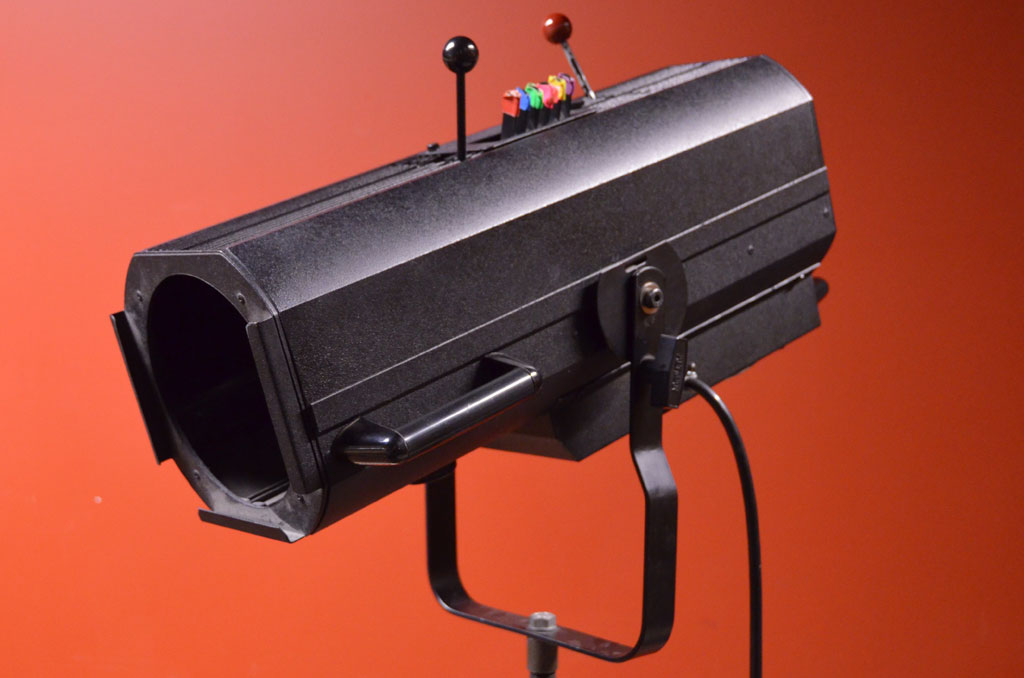
Despite what many people believe, running a followspot is one of the trickier tech jobs in a theatre. Operating one isn’t just a matter of making sure it’s turned on and off at the right times and pointed at the right person. Because the spotlight itself is so short compared to the length of the beam it projects, even the smallest motion of the spot becomes a movement of several feet at the end of the light beam. Here are some tips to help you be a super-steady spot operator:
Adjust the followspot to a comfortable height. If you’re reaching way above or below you, then it is extremely difficult to move the spot smoothly. Also make sure you can reach the controls easily.
Make sure the yoke isn’t tightened down. If you are trying to move the spot against a tightened yoke, it will jerk every time the friction is overcome. You should be holding the spot up the whole time it is on, so there’s no reason to have the yoke hold it.
Make sure you have the right parts of the stand tight/loose. Many followspots have two bolts at the point on the stand where the height adjustment is. One is just a ring that fits around the top part of the stand. This is what actually holds the spot at the proper height when it is in use, so it should be tight. The other one makes it so that the smaller top tube can’t move inside the larger bottom tube. You want to leave this one loose so that the spot can be moved left and right easily.
Brace the spot against your body. If you’re reaching way out in front of you, the movement of the spot will invariably be jittery. If you are bracing it against yourself, not only do you shorten how far you have to reach, you can use your whole body to make smaller moves more smoothly. You are also less likely to accidentally move the spot when you move your hands to work the spot’s controls.
Use the shutter to turn the light on and off, not the power switch. Some spots have lamps that take a while to warm up, so you can’t just turn on the power when you are ready for light. Other spots just have standard incandescent lamps, so they can be turned on and off at will. Either way, using the shutter is a much better way to go. The control for the shutter is usually in a more convenient location than the power switch, so you can operate it more easily. It is also generally quieter than the power switch.
Target practice. There are few things more distracting during a show than seeing a spotlight appear on the ceiling, then swerve around until it finally lands on the right actor. The spot should already be aimed perfectly by the time you open the shutter to turn on the light. Getting the hang of this takes lots of practice, so whenever you have downtime, work on aiming at various targets throughout the theatre and see how close your aim is when you turn on the light.
More target practice. You should be able to perfectly follow an actor around the stage with your spot (hence the name “followspot”!) Have someone help you practice this by running around the stage, randomly changing directions and speeds. You should be able to keep the light on them without it getting ahead of or falling behind them. Eventually you will learn how much to move the spotlight itself to shift the end of the light beam the desired amount. Your movements will also become smoother and smoother.
Learn the controls. You don’t want to accidentally make the beam huge when it’s supposed to shrink down to nothing. Figure out what all the controls do, and practice with them until they’re second nature.
Human vision is very sensitive to movement. When you’re running a followspot, it’s easy to move the light too much or too little and distract the audience from the show. With some practice, however, you can be a smooth and stealthy spot operator.
